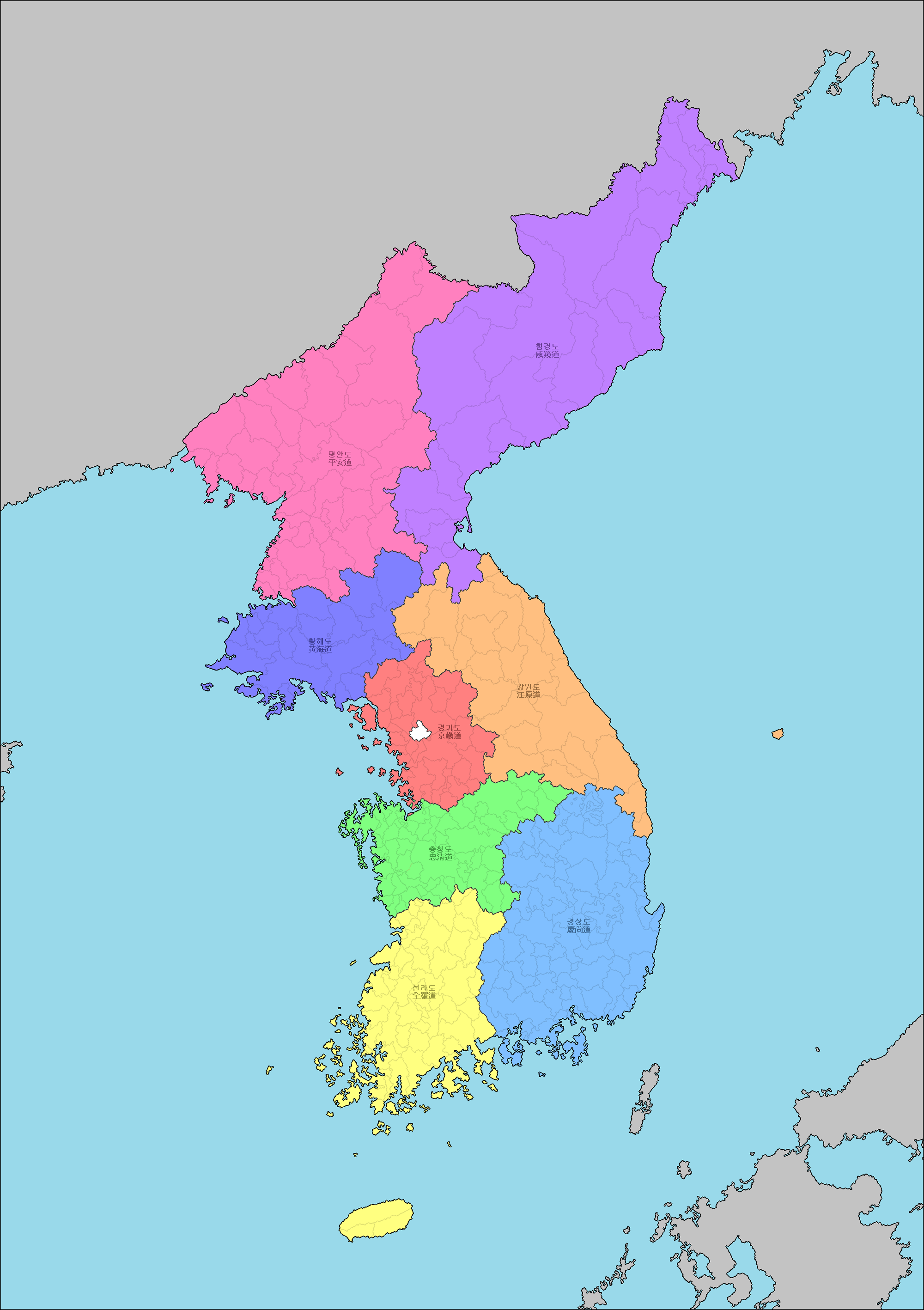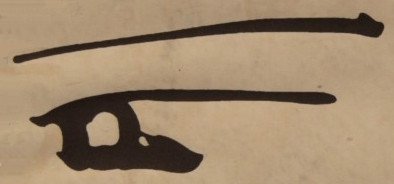|
Gyeonggi (region)
Gyeonggi (), alternatively spelled Kyŏnggi or Kyunggi, is a region of the Korean Peninsula that has historically occupied the west-central region of Korea. In modern times, the region hosts South Korea's Gyeonggi Province and Incheon Metropolitan City, and North Korea's Kaesong Industrial Region, and Changpung, and Ch'ŏrwŏn counties. Etymology The current name of the region, ''Gyeonggi'', comes from a combination of ''Gyeong'' (京/경; "capital") and ''Gi'' (畿/기; "near"), ultimately from ''Gyeonghyeon'' (京縣/경현) and ''Gihyeon'' (畿縣/기현) in relation to the location of the capital, Gaegyeong (modern day Kaesŏng, North Korea). The name means "Area Surrounding the Capital", and was first used in 1018 during the Goryeo dynasty. Prior, the region was called ''Gwannae-do'' (關內道/관내도). History Unified Silla and Goryeo Towards the end of the Three Kingdoms period, the southeastern kingdom of Silla unified the Korean Peninsula up to the Taedon ... [...More Info...] [...Related Items...] OR: [Wikipedia] [Google] [Baidu] |
Regions Of Korea
Korea has traditionally been divided into a number of unofficial regions that reflect historical, geographical, and dialect boundaries within the peninsula. Many of the names in the list below overlap or are obsolete today, with Honam, Yeongdong, Yeongnam, and the modern term Sudogwon being the only ones in wide use. The names of Korea's traditional Eight Provinces are often also used as regional monikers. List of eight regions Extra regions See also * Eight Provinces of Korea * Korean dialects A number of Korean dialects are spoken in Korea and by the Korean diaspora. The peninsula is very mountainous and each dialect's "territory" corresponds closely to the natural boundaries between different geographical regions of Korea. Most of t ... * Provinces of Korea * Yanbian Korean Autonomous Prefecture in Jilin, Northeast China References {{Regions and administrative divisions of South Korea Regions of Korea, ... [...More Info...] [...Related Items...] OR: [Wikipedia] [Google] [Baidu] |
Taedong River
The Taedong River () is a large river in North Korea. The river rises in the Rangrim Mountains of the country's north where it then flows southwest into Korea Bay at Namp'o.Suh, Dae-Sook (1987) "North Korea in 1986: Strengthening the Soviet Connection" ''Asian Survey'' 27(1): pp. 56-63, page 62 In between, it runs through the country's capital, Pyongyang. Along the river are landmarks such as the Juche Tower and Kim Il-sung Square. The river is in length, and is generally deep. It is the fifth-longest river on the Korean peninsula and the second-longest in North Korea. Pyongyang is approximately 110 km upstream from the mouth, Sunchon 192 km upstream, and Taehŭng 414 km upstream. Because of its depth, it is widely used for river transport; it is navigable by large ships up to 65 km inland, although most commercial traffic stops at Songrim. History The kingdom of Koguryo was founded on its shores. Many archeological sites dating to the Neolithic and ... [...More Info...] [...Related Items...] OR: [Wikipedia] [Google] [Baidu] |
Japanese Language
is the principal language of the Japonic languages, Japonic language family spoken by the Japanese people. It has around 123 million speakers, primarily in Japan, the only country where it is the national language, and within the Japanese diaspora worldwide. The Japonic family also includes the Ryukyuan languages and the variously classified Hachijō language. There have been many Classification of the Japonic languages, attempts to group the Japonic languages with other families such as Ainu languages, Ainu, Austronesian languages, Austronesian, Koreanic languages, Koreanic, and the now discredited Altaic languages, Altaic, but none of these proposals have gained any widespread acceptance. Little is known of the language's prehistory, or when it first appeared in Japan. Chinese documents from the 3rd century AD recorded a few Japanese words, but substantial Old Japanese texts did not appear until the 8th century. From the Heian period (794–1185), extensive waves of Sino-Ja ... [...More Info...] [...Related Items...] OR: [Wikipedia] [Google] [Baidu] |
Keijō
, or Gyeongseong (), was an administrative district of Korea under Japanese rule that corresponds to the present Seoul, the capital of South Korea. History When the Empire of Japan annexed the Korean Empire, it made Seoul the colonial capital. While under colonial rule (1910–1945), the city was called Keijō (; , literally meaning "capital city" in Hanja Hanja (; ), alternatively spelled Hancha, are Chinese characters used to write the Korean language. After characters were introduced to Korea to write Literary Chinese, they were adapted to write Korean as early as the Gojoseon period. () ....). Keijō was an urban city () that had 2 wards: Keijō itself and Ryusan-ku (龍山區, , ). Gyeongseong was part of Gyeonggi Province, instead of being an independent city or prefecture as in Joseon and present days. In 1914, several outer districts of the prefecture were annexed to neighboring Goyang County (now Goyang City, reducing the administrative size of the prefe ... [...More Info...] [...Related Items...] OR: [Wikipedia] [Google] [Baidu] |
Kanji
are logographic Chinese characters, adapted from Chinese family of scripts, Chinese script, used in the writing of Japanese language, Japanese. They were made a major part of the Japanese writing system during the time of Old Japanese and are still used, along with the subsequently-derived Syllabary, syllabic scripts of and . The characters have Japanese pronunciations; most have two, with one based on the Chinese sound. A few characters were invented in Japan by constructing character components derived from other Chinese characters. After the Meiji Restoration, Japan made its own efforts to simplify the characters, now known as , by a process similar to China's simplified Chinese characters, simplification efforts, with the intention to increase literacy among the general public. Since the 1920s, the Japanese government has published character lists periodically to help direct the education of its citizenry through the myriad Chinese characters that exist. There are nearly 3 ... [...More Info...] [...Related Items...] OR: [Wikipedia] [Google] [Baidu] |
Korea Under Japanese Rule
From 1910 to 1945, Korea was ruled by the Empire of Japan under the name Chōsen (), the Japanese reading of "Joseon". Japan first took Korea into its sphere of influence during the late 1800s. Both Korea (Joseon) and Japan had been under policies of isolationism, with Joseon being a Tributary system of China, tributary state of Qing China. However, in 1854, Perry Expedition, Japan was forcibly opened by the United States. It then rapidly modernized under the Meiji Restoration, while Joseon continued to resist foreign attempts to open it up. Japan eventually succeeded in opening Joseon with the unequal Japan–Korea Treaty of 1876. Afterwards, Japan embarked on a decades-long process of defeating its local rivals, securing alliances with Western powers, and asserting its influence in Korea. Japan Assassination of Empress Myeongseong, assassinated the defiant Korean queen and intervened in the Donghak Peasant Revolution.Donald Keene, ''Emperor of Japan: Meiji and his World, 1852� ... [...More Info...] [...Related Items...] OR: [Wikipedia] [Google] [Baidu] |
Empire Of Japan
The Empire of Japan, also known as the Japanese Empire or Imperial Japan, was the Japanese nation state that existed from the Meiji Restoration on January 3, 1868, until the Constitution of Japan took effect on May 3, 1947. From Japan–Korea Treaty of 1910, 1910 to Japanese Instrument of Surrender, 1945, it included the Japanese archipelago, the Kuril Islands, Kurils, Karafuto Prefecture, Karafuto, Korea under Japanese rule, Korea, and Taiwan under Japanese rule, Taiwan. The South Seas Mandate and Foreign concessions in China#List of concessions, concessions such as the Kwantung Leased Territory were ''de jure'' not internal parts of the empire but dependent territories. In the closing stages of World War II, with Japan defeated alongside the rest of the Axis powers, the Japanese Instrument of Surrender, formalized surrender was issued on September 2, 1945, in compliance with the Potsdam Declaration of the Allies of World War II, Allies, and the empire's territory subsequent ... [...More Info...] [...Related Items...] OR: [Wikipedia] [Google] [Baidu] |
Korean Empire
The Korean Empire, officially the Empire of Korea or Imperial Korea, was a Korean monarchical state proclaimed in October 1897 by King Gojong of the Joseon dynasty. The empire lasted until the Japanese annexation of Korea in August 1910. During this period, Emperor Gojong oversaw the Gwangmu Reform, a partial modernization and westernization of Korea's military, economy, land system, education system, and various industries. In 1905, the Korean Empire became a protectorate of the Empire of Japan. After the Japanese annexation in 1910, the Korean Empire ceased to exist. History Formation Resistance against Korea having a tributary relationship with China increased in the 17th century. As the Ming dynasty was replaced by Qing dynasty, Western ideas entering Korea had caused anti-tributary sentiments to rise in Korea. Moreover, after the opening of Korea, members of the Gaehwa Party often declared independence from China, but China increased its interference in Korean aff ... [...More Info...] [...Related Items...] OR: [Wikipedia] [Google] [Baidu] |
Gojong Of Korea
Gojong (; 8 September 1852 – 21 January 1919), personal name Yi Myeongbok (), later Yi Hui (), also known as the Gwangmu Emperor (), was the penultimate List of monarchs of Korea, Korean monarch. He ruled Korea for 43 years, from 1864 to 1907, first as the last king of Joseon, and then as the first Korean imperial titles#Joseon, emperor of the Korean Empire from 1897 until his forced abdication in 1907. His wife, Empress Myeongseong, Queen Min (posthumously honored as Empress Myeongseong), played an active role in politics until Assassination of Empress Myeongseong, her assassination carried out by the Japanese. Gojong oversaw the bulk of the Korean monarchy's final years. He was born into the ruling House of Yi, and was first crowned on 13 December 1863 at the age of twelve. His biological father, Grand Internal Prince Heungseon (widely known as Heungseon Daewongun), acted as regent until he reached the age of majority, although he continued holding power until 1874. At thi ... [...More Info...] [...Related Items...] OR: [Wikipedia] [Google] [Baidu] |
Eight Provinces Of Korea
During most of the Joseon dynasty, Korea was divided into eight provinces ('' do''; ). The eight provinces' boundaries remained unchanged for about 480 years from 1413 to 1895, and formed a geographic paradigm that is still reflected today in the Korean Peninsula's administrative divisions, dialects, and regional distinctions. The names of all eight provinces are still preserved today, in one form or another. These eight historical provinces form both North and South Korea, and are not to be confused with the provinces that make up North Korea or South Korea. History Provinces before 1895 In 1413 (the 13th year of the reign of King Jeongjong), the north-eastern boundary of Korea was extended to the Tumen River. The country was reorganized into eight provinces: Chungcheong, Gangwon, Gyeonggi, Gyeongsang, Jeolla, P'unghae (renamed Hwanghae in 1417), P'yŏngan, and Yŏnggil (eventually renamed Hamgyŏng in 1509). Districts of 1895–96 For almost 500 years, the ei ... [...More Info...] [...Related Items...] OR: [Wikipedia] [Google] [Baidu] |
Taejo Of Joseon
Taejo (; 4 November 1335 – 27 June 1408), personal name Yi Seong-gye (), later Yi Dan (), was the founder and first monarch of the Joseon dynasty of Korea. After overthrowing the Goryeo dynasty, he ascended to the throne in 1392 and abdicated six years later during a strife between his sons. He was honored as Emperor Go () following the establishment of the Korean Empire. Taejo emphasized continuity over change. No new institutions were created, and no massive purges occurred during his reign. His new dynasty was largely dominated by the same ruling families and officials that had served the previous regime. He re-established amicable ties with Japan and improved relations with Ming dynasty, Ming China. Biography Early life The future King Taejo was born in Ssangseong Prefecture on the frontiers of the Yuan dynasty. Taejo's father was Yi Cha-ch'un, an official of Korean ethnicity serving the Mongols, Mongol-led Yuan. His mother, Queen Uihye, Lady Ch'oe, came from a famil ... [...More Info...] [...Related Items...] OR: [Wikipedia] [Google] [Baidu] |




